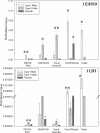Divergent expression of 11beta-hydroxysteroid dehydrogenase and 11beta-hydroxylase genes between male morphs in the central nervous system, sonic muscle and testis of a vocal fish
- PMID: 20178798
- PMCID: PMC2862803
- DOI: 10.1016/j.ygcen.2010.02.021
Divergent expression of 11beta-hydroxysteroid dehydrogenase and 11beta-hydroxylase genes between male morphs in the central nervous system, sonic muscle and testis of a vocal fish
Abstract
The vocalizing midshipman fish, Porichthys notatus, has two male morphs that exhibit alternative mating tactics. Only territorial males acoustically court females with long duration (minutes to >1h) calls, whereas sneaker males attempt to steal fertilizations. During the breeding season, morph-specific tactics are paralleled by a divergence in relative testis and vocal muscle size, plasma levels of the androgen 11-ketotestosterone (11KT) and the glucocorticoid cortisol, and mRNA expression levels in the central nervous system (CNS) of the steroid-synthesizing enzyme aromatase (estrogen synthase). Here, we tested the hypothesis that the midshipman's two male morphs would further differ in the CNS, as well as in the testis and vocal muscle, in mRNA abundance for the enzymes 11beta-hydroxylase (11betaH) and 11beta-hydroxysteroid dehydrogenase (11betaHSD) that directly regulate both 11KT and cortisol synthesis. Quantitative real-time PCR demonstrated male morph-specific profiles for both enzymes. Territorial males had higher 11betaH and 11betaHSD mRNA levels in testis and vocal muscle. By contrast, sneaker males had the higher CNS expression, especially for 11betaHSD, in the region containing an expansive vocal pacemaker circuit that directly determines the temporal attributes of natural calls. We propose for territorial males that higher enzyme expression in testis underlies its greater plasma 11KT levels, which in vocal muscle provides both gluconeogenic and androgenic support for its long duration calling. We further propose for sneaker males that higher enzyme expression in the vocal CNS contributes to known cortisol-specific effects on its vocal physiology.
Copyright 2010 Elsevier Inc. All rights reserved.
Figures


Similar articles
-
Glucocorticoid and androgen signaling pathways diverge between advertisement calling and non-calling fish.Horm Behav. 2012 Sep;62(4):426-32. doi: 10.1016/j.yhbeh.2012.07.010. Epub 2012 Aug 4. Horm Behav. 2012. PMID: 22884426
-
Corticosteroid receptor expression in a teleost fish that displays alternative male reproductive tactics.Gen Comp Endocrinol. 2010 Jan 1;165(1):83-90. doi: 10.1016/j.ygcen.2009.06.004. Epub 2009 Jun 12. Gen Comp Endocrinol. 2010. PMID: 19524581 Free PMC article.
-
Localization and divergent profiles of estrogen receptors and aromatase in the vocal and auditory networks of a fish with alternative mating tactics.J Comp Neurol. 2013 Aug 15;521(12):2850-69. doi: 10.1002/cne.23320. J Comp Neurol. 2013. PMID: 23460422 Free PMC article.
-
Molecular biology of 11β-hydroxylase and 11β-hydroxysteroid dehydrogenase enzymes.J Steroid Biochem Mol Biol. 1992 Dec;43(8):827-35. doi: 10.1016/0960-0760(92)90309-7. J Steroid Biochem Mol Biol. 1992. PMID: 22217826 Review.
-
Sex steroid levels in Porichthys notatus, a fish with alternative reproductive tactics, and a review of the hormonal bases for male dimorphism among teleost fishes.Horm Behav. 1993 Sep;27(3):332-47. doi: 10.1006/hbeh.1993.1025. Horm Behav. 1993. PMID: 8225257 Review.
Cited by
-
Effects of cortisol on female-to-male sex change in a wrasse.PLoS One. 2022 Sep 1;17(9):e0273779. doi: 10.1371/journal.pone.0273779. eCollection 2022. PLoS One. 2022. PMID: 36048785 Free PMC article.
-
Contextual modulation of social and endocrine correlates of fitness: insights from the life history of a sex changing fish.Front Neurosci. 2015 Feb 3;9:8. doi: 10.3389/fnins.2015.00008. eCollection 2015. Front Neurosci. 2015. PMID: 25691855 Free PMC article. Review.
-
A new experimental model for the investigation of sequential hermaphroditism.Sci Rep. 2021 Nov 24;11(1):22881. doi: 10.1038/s41598-021-02063-y. Sci Rep. 2021. PMID: 34819550 Free PMC article.
-
Neuroendocrine control of seasonal plasticity in the auditory and vocal systems of fish.Front Neuroendocrinol. 2015 Apr;37:129-45. doi: 10.1016/j.yfrne.2014.08.002. Epub 2014 Aug 26. Front Neuroendocrinol. 2015. PMID: 25168757 Free PMC article. Review.
-
Catecholaminergic Fiber Innervation of the Vocal Motor System Is Intrasexually Dimorphic in a Teleost with Alternative Reproductive Tactics.Brain Behav Evol. 2015;86(2):131-44. doi: 10.1159/000438720. Epub 2015 Sep 11. Brain Behav Evol. 2015. PMID: 26355302 Free PMC article.
References
-
- Bass AH. Shaping brain sexuality. Am. Sci. 1996;84:352–363.
-
- Bass AH, Bodnar DA, Marchaterre MA. Complementary explanations for existing phenotypes in an acoustic communication system. In: Hauser M, Konishi M, editors. Neural Mechanisms of Communication. MIT Press; Cambridge, MA: 1999. pp. 493–514.
-
- Bass AH, Forlano PH. Neuroendocrine mechanisms of alternative reproductive tactics: The chemical language of social plasticity. In: Oliveira RF, Taborsky M, Brockmann HJ, editors. Alternative Reproductive Tactics - an Integrative Approach. Cambridge Univ. Press; 2008. pp. 109–131.
-
- Bass AH, Grober MS. Reproductive Plasticity in fish: Evolutionary liability in the patterning of neuroendocrine and behavioral traits underlying divergent sexual phenotypes. In: Pfaff D, Arnold A, Etgen A, Fahrbach S, Moss R, Rubin R, editors. Hormones, Brain, and Behavior. Academic Press; 2009.
Publication types
MeSH terms
Substances
Grants and funding
LinkOut - more resources
Full Text Sources

